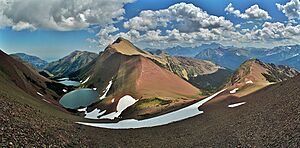Mount Alderson facts for kids
Quick facts for kids Mount Alderson |
|
|---|---|
 |
|
| Highest point | |
| Elevation | 2,692 m (8,832 ft) |
| Prominence | 712 m (2,336 ft) |
| Parent peak | Mount Custer (2707 m) |
| Geography | |
| Location | Alberta, Canada |
| Parent range | Clark Range Canadian Rockies |
| Topo map | NTS 82H04 |
| Geology | |
| Age of rock | Cambrian |
Mount Alderson is a tall mountain in Waterton Lakes National Park, Alberta, Canada. It stands at about 2,692 meters (8,832 feet) high. This impressive peak is part of the Canadian Rockies, a huge mountain range.
Mount Alderson is close to other important peaks. Its closest higher neighbor is Mount Custer, about 8 kilometers (5 miles) to the southwest. You can also find Mount Richards about 2 kilometers (1.2 miles) to the southeast. Bertha Peak is right next to it, to the northeast.
History of Mount Alderson's Name
Mount Alderson was named to honor a very important person. The mountain is named after Sir Edwin Alfred Hervey Alderson. He was a senior British Army officer. Sir Edwin served in many military campaigns in the late 1800s and early 1900s. He even commanded the Canadian Corps during World War I.
The name for Mount Alderson became official in 1943. This decision was made by the Geographical Names Board of Canada.
How Mount Alderson Was Formed
Like other mountains in Waterton Lakes National Park, Mount Alderson is made of sedimentary rock. This type of rock forms from layers of sand, mud, and tiny bits of plants and animals. These layers built up over millions of years, from the Precambrian to the Jurassic periods.
These rocks were first laid down in shallow seas. Later, during a time called the Laramide orogeny, huge forces pushed these rock layers. They were pushed eastward and even slid over younger rocks from the Cretaceous period. This process created the tall mountains we see today.
Climate Around Mount Alderson
Mount Alderson is located in a subarctic climate zone. This means it has very cold and snowy winters. The summers are usually mild, not too hot. Temperatures can drop below −20 °C (−4 °F). With the wind, it can feel even colder, sometimes below −30 °C (−22 °F).
All the rain and melting snow from Mount Alderson flows into Waterton Lake. From there, the water continues into the Waterton River.




